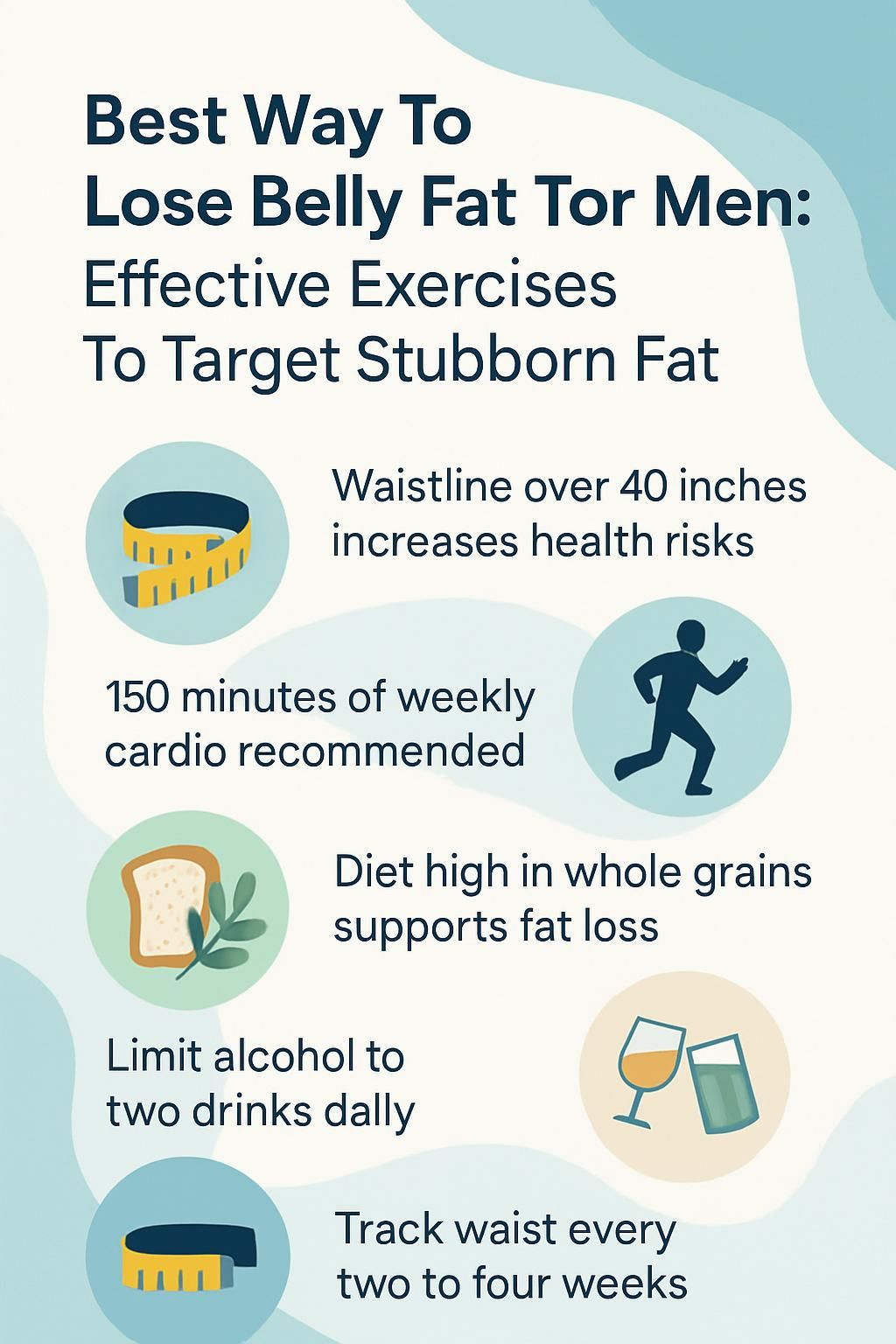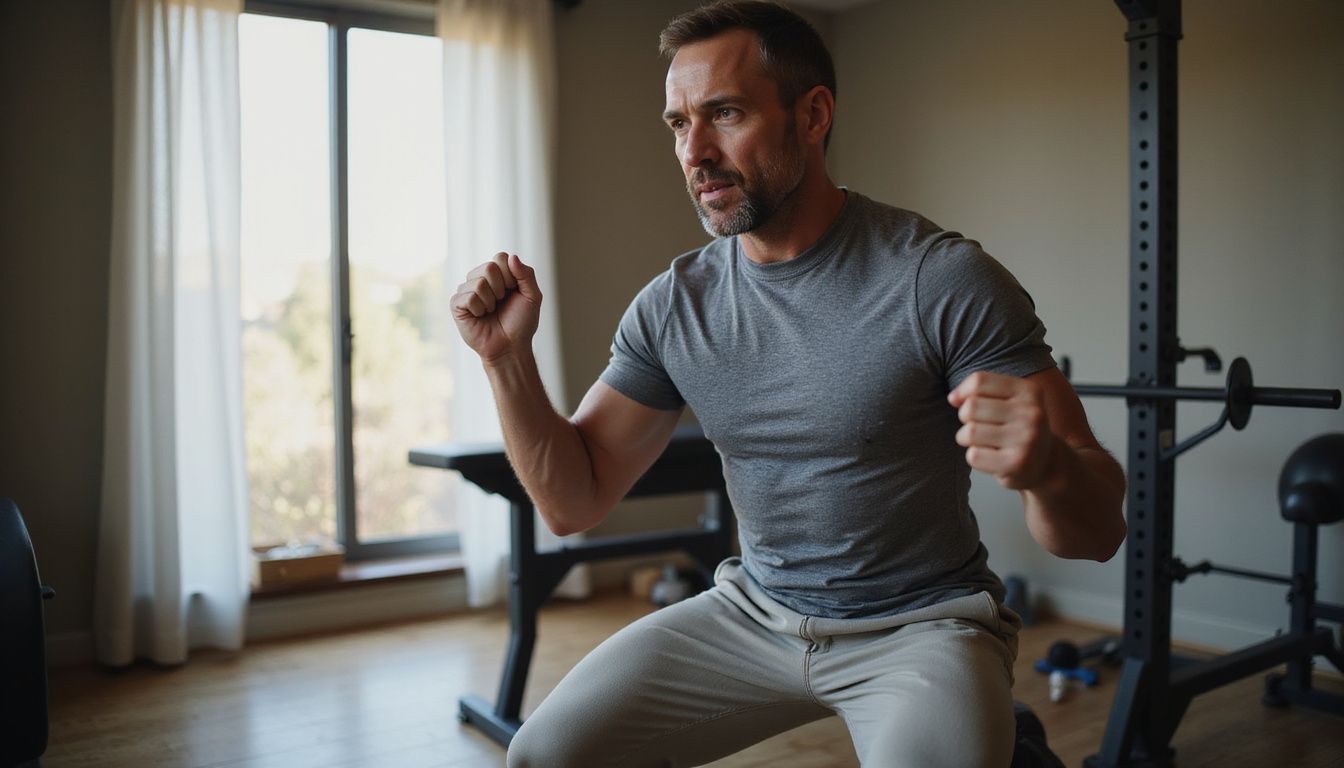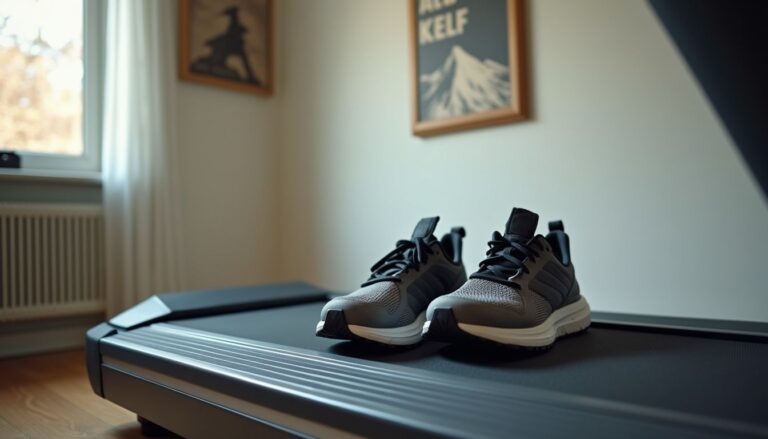Best Way To Lose Belly Fat For Men: Effective Exercises To Target Stubborn Fat
Our Nutrition Assistant AI Suite will transform your body. You will lose fat, get toned, and build muscle. Gain confidence and optimal health.
If you are trying to lose belly fat and progress feels slow, you are not alone. Extra fat around your belly raises your risk for heart disease, type 2 diabetes, and other health issues.
This guide on the Best Way To Lose Belly Fat For Men explains why visceral fat, the deep fat around your organs, is risky. You will learn evidence-based diet strategies and practical exercises like strength training and aerobic exercise that target stubborn areas. Keep reading for clear steps that help you get rid of belly fat and boost your well-being.
Key Takeaways
- Men with a waistline over 40 inches face higher risks for heart disease and diabetes. Reducing visceral fat matters more than lowering BMI alone.
- Pair at least 150 minutes per week of cardio with strength training twice weekly. Adding HIIT can reduce stubborn belly fat faster (Maillard F, 2018).
- Eating whole grains, lean protein, and healthy fats, while limiting refined carbs, supports steady abdominal fat loss (Framingham Heart Study).
- Limiting alcohol to no more than two drinks daily, per CDC guidance, cuts empty calories linked with abdominal weight gain.
- Track waist circumference above your hip bone every two to four weeks. It shows belly fat changes better than scale weight alone.

Key Factors About Belly Fat in Men

Belly fat in men increases the risk for metabolic syndrome, type 2 diabetes, and cardiovascular disease. Understanding how your body stores visceral fat helps you choose the right diet and exercise to lose it.
What Are the Health Risks of Belly Fat?
Excess fat around your belly raises your risk of serious conditions. Men with a waistline above 40 inches have higher odds of heart disease, stroke, and type 2 diabetes.
Visceral fat pushes blood pressure and blood sugar higher. It can worsen sleep apnea by making breathing harder at night. High levels often come with elevated triglycerides and poor blood vessel function.
Carrying more abdominal fat links to certain cancers and fatty liver disease. Studies show men with more visceral fat tend to have shorter lifespans than those with less. Trimming belly fat improves circulation and may lower the chance of high cholesterol and cardiac events.
How Do Visceral and Subcutaneous Fat Differ?
Subcutaneous fat sits under your skin. You can pinch it around your waist or thighs. Visceral fat sits deeper in the abdomen, wrapping your liver, pancreas, and intestines. This hidden fat drives higher risk for heart disease and diabetes.
Waist circumference signals visceral fat better than BMI. Health experts agree that targeting visceral fat should be a top goal for men who want fat loss. Even people who look thin can carry high visceral fat that you cannot see or pinch.
Imaging tests can measure this deep fat, but you can manage it through healthy eating and regular aerobic activity. Reducing body weight usually shrinks your waist faster than focusing only on surface fat.
Visceral fat hides out of sight, but it carries higher risk.
Doing hundreds of crunches will not burn belly fat from one spot. Whole-body physical activity helps reduce both types while improving muscle mass and metabolism.
How Do Genetics and Aging Affect Belly Fat?
Genetics guide where your body stores fat, including your waist. If your parents carried extra belly fat, you may find it tougher to keep your waistline down.
As you age, hormone shifts and a slower metabolism change how your body uses calories. Muscle mass drops with each decade. That lowers daily energy burn and raises body fat percentage, even when habits stay the same.
Men in their 50s usually need about 200 fewer calories per day than in their 30s. Falling testosterone after about age 40 also encourages more abdominal fat storage. With these changes, you may need updated strategies that fit your age and genetics.
Dietary Strategies to Minimize Belly Fat
Your food choices make a big difference. Smart, steady changes help you lose belly fat and protect your health.
What Whole, Unprocessed Foods Should I Eat?
Whole, unprocessed foods support fat loss and better body composition. They also deliver fiber, protein, and healthy fats that keep you full.
- Choose fruits like apples, berries, bananas, and oranges for fiber that fills you up and supports digestion.
- Load up on vegetables such as leafy greens, broccoli, carrots, and bell peppers. They add volume without many calories or added sugar.
- Pick whole grains like brown rice, oats, barley, and quinoa. More soluble fiber links to lower belly fat over time.
- Include lean proteins like fish, skinless poultry, eggs, beans, tofu, and low-fat dairy to build muscle while losing fat.
- Get healthy fats from nuts, seeds, olive oil, and fatty fish rich in omega-3s.
- Add legumes, including lentils and black beans. They provide protein plus complex carbs for steady energy.
- Limit convenience foods high in trans fat and refined carbs, which often add fat around the waistline.
- Snack on raw veggies or fresh fruit instead of sweetened beverages or soft drinks to avoid added sugar.
- Drink water throughout the day to stay hydrated, support metabolism, and help control appetite.
Build most meals from whole foods. This keeps calories in check and supports lasting fat loss.
How Can I Reduce Refined Carbs and Sugars?
Refined carbs and added sugars make belly fat easier to gain. Small daily swaps can make a real difference.
- Trade soda, sweet tea, and punch for water or sugar-free drinks. This cuts calories and avoids blood sugar spikes.
- Skip fruit juice. An 8 ounce apple juice has about 24 grams of sugar, including fructose, which links to abdominal fat.
- Read labels. Many “low-fat” items are high in sugar and refined carbs.
- Choose whole grains over refined grains. In the Framingham Heart Study, high whole grain eaters had less abdominal fat.
- Limit highly processed foods. Many contain trans fats that drive inflammation and visceral fat.
- Cut back on white-flour baked goods, candy, and chips. They add calories with little nutrition.
- Base snacks on lean meat, vegetables, nuts, and seeds instead of packaged refined carbs.
- Use olive oil or avocado instead of spreads with hydrogenated oils.
- Skip sugary mixers in drinks. They add hidden sugars that slow progress.
- Build meals around protein, plus vegetables and whole foods, to steady appetite hormones.
What Are the Benefits of Omega-3s and Healthy Fats?
Fatty fish like salmon, herring, sardines, mackerel, and anchovies provide protein and omega-3 fatty acids. Eating fish two to three times weekly may help reduce visceral fat around your organs.
Omega-3s support heart health and calm inflammation. Replace saturated and trans fats with healthier options such as nuts, olive oil, and avocado. If you do not eat fish, a plant-based omega-3 supplement can help. These fats aid metabolism and may support a healthy weight.
How Does a High-Protein Diet Help Control Weight?
Higher protein intake helps you feel full longer, which makes a calorie deficit easier. Protein-rich foods like meat, fish, eggs, dairy, whey, and beans can raise daily calorie burn because protein requires more energy to digest.
Protein also protects lean muscle during weight loss. That helps you lose fat instead of muscle mass, which keeps your resting metabolism stronger. Both animal and plant proteins can help shrink your waistline and support weight maintenance.
How Much Alcohol Should I Drink to Support Fat Loss?
Alcohol adds empty calories that collect around your midsection. Drinking most days, especially more than two drinks, links to more abdominal fat.
CDC guidance for men suggests no more than two alcoholic drinks per day. Consider swapping weekend beers for sparkling water or a nonalcoholic option. Many people notice better sleep and a shrinking waistline after cutting back on alcohol.
Exercises Specifically Targeting Belly Fat
Exercise is your engine. The right mix helps burn more calories, lower visceral fat, and shape your waist.
Why Combine Cardio and Strength Training?
Cardio and strength work better together than alone. Aerobic activities like brisk walking or cycling burn calories and use stored fatty acids, including those around your waist.
Aim for at least 150 minutes per week of moderate cardio, or 75 minutes of vigorous cardio. Strength training twice weekly preserves muscle and raises your resting metabolism. Studies from Johns Hopkins also show that combining healthy eating with regular exercise can improve artery function in people with excess weight.
How Does High-Intensity Interval Training (HIIT) Help?
High-intensity interval training makes you push hard for short bursts, then rest. Research by Maillard and colleagues in 2018, published in Sports Medicine, found HIIT can reduce both subcutaneous fat and visceral fat more than steady moderate exercise.
Short HIIT sessions fit busy schedules and keep your metabolism higher after you stop. That helps with faster fat loss without losing much muscle. Many people use HIIT to attack stubborn belly fat while saving time.
How Can Weightlifting Build Lean Muscle?
Weightlifting builds lean muscle, which burns more calories even at rest. It also helps maintain muscle during lower-calorie phases.
Research from 2022 shows resistance training supports fat loss and pairs well with aerobic exercise. If you are over 30, lifting helps fight age-related muscle decline. Include weight training at least two days per week.
If you are new to lifting, check with your doctor or a certified trainer. To firm your midsection, add the core moves below.
What Are the Best Core Exercises Like Planks and Crunches?
Core exercises build strength and stability. While they do not burn belly fat from one spot, they support posture and help your workouts.
- Plank strengthens your entire core, including abs, lower back, and shoulders. Hold for 30 seconds with solid form.
- Crunch targets the front abdominal muscle called the rectus abdominis. Use controlled movement on a mat.
- Side plank trains the obliques along your waist. Build time slowly to improve lateral stability.
- Bicycle crunch adds rotation and engages more muscle fibers while raising heart rate slightly.
- Mountain climber challenges the core and adds cardio, which supports calorie burn.
- Leg raise targets the lower abs. Move with control to protect your spine.
- Push-up works chest, arms, and core at the same time. Better core strength can lower injury risk.
Next, choose cardio options that fit your joints, schedule, and goals.
Which Cardio Options Are Effective: Running, Cycling, Swimming?
Running, cycling, and swimming all help reduce belly fat in men. Pick one main option and add variety for motivation and recovery.
- Running boosts metabolism and burns many calories per session. Hitting 150 minutes per week can help lower insulin levels and trim your waist.
- Cycling is low impact and suits most fitness levels. It protects joints while targeting fat stores.
- Swimming is gentle on joints and trains your whole body. Gradually raising your weekly minutes can increase fat loss.
- Brisk walking builds fitness, grows small blood vessels that support the heart, and is easy to stick with.
- Mixing cardio prevents boredom and works different muscle groups. That often improves consistency and long-term results.
- If you have prediabetes, pairing running and cycling may help control blood sugar while your waistline tightens.
- Cardio works best with strength training. Building muscle increases calorie burn and helps maintain weight loss.
Lifestyle Modifications for Reducing Belly Fat
Daily habits matter as much as your workouts. Simple shifts help your body burn more fat and manage stress hormones like cortisol.
How Does Quality Sleep Affect Belly Fat?
Seven or more hours of quality sleep supports weight loss and belly fat control. In a 16 year study of over 68,000 women, those sleeping under five hours gained more weight than those sleeping seven or more.
Poor sleep upsets hormones that regulate appetite and stress, including cortisol. Short sleep also links to more visceral fat. Treating sleep apnea and setting a steady sleep schedule can improve metabolism and recovery after exercise.
How Can Managing Stress Lower Cortisol Levels?
High stress raises cortisol, a hormone that can boost appetite and drive cravings for refined carbs and sugar. Over time, this pattern adds fat, especially around your waist.
Simple tools help. Try slow breathing, brief meditations, or a short yoga flow. These practices support better hormone balance and weight control. Lower cortisol can reduce health risks tied to belly fat, including high cholesterol.
Why Is Hydration Important for Metabolism and Digestion?
Water supports metabolism and digestion, which helps fat loss. Replacing sugary drinks with water cuts calories and reduces blood sugar swings.
Staying hydrated may improve fat burning and appetite control. It also boosts exercise performance and recovery, both key for shrinking your waistline. Choose water first to support healthy digestion and heart health over time.
What Are Simple Ways to Reduce Sedentary Time?
Long sitting periods can raise your risk for health problems and more belly fat. Small changes keep your metabolism active throughout the day.
- Stand and walk for a few minutes every 30 to 60 minutes.
- Hold standing or walking meetings to add steps without extra gym time.
- Walk during phone calls. Those steps add up fast.
- Use stairs when possible for quick activity bursts.
- Wear an activity tracker. Set step goals and move alerts.
- Park farther away to increase daily steps.
- Set phone alarms for stretch breaks during TV or computer time.
- Do active chores like vacuuming, sweeping, or yard work.
- Invite family for a short walk after dinner to increase movement and lower stress.
These simple habits keep you moving and support steady fat loss.
Avoiding Common Belly Fat Reduction Mistakes
Many men focus on ab moves and hope for fast trimming. You will get better results by using smart diet changes and full-body training.
Why Aren’t Ab-Only Exercises Enough?
Spot targeting does not work. Crunches and sit-ups strengthen core muscles, but they will not shrink your waistline by themselves.
Visceral fat responds best to calorie control and full-body exercise. Cardio plus strength training burns more calories and improves metabolism. Ab moves alone often build muscle under the fat, so you may not see change until total body fat drops.
Use a mix of healthy eating, regular workouts, good sleep, hydration, and less sitting for real results. If you switch from only crunches to cycling and cutting back on alcohol and sugar, your tape measure will likely show progress within weeks.
What Are the Risks of Extreme Diets and Quick Fixes?
Crash plans may drop pounds fast, but much of that is water or muscle. Very low-calorie plans and detoxes can slow your metabolism and cause nutrient gaps.
Overly strict rules can raise stress and cortisol, which may push more belly fat storage. If you feel anxious about food or notice unsafe patterns, call the SAMHSA helpline at 1-800-662-4357 for support.
Shortcuts do not last. Most people regain weight after ending extreme plans. Choose steady, sustainable changes built around whole foods.
Why Is Consistency Important in Fat Loss?
Consistency builds habits that carry you through tough days. A steady routine lets your metabolism adjust, which supports ongoing fat loss, including abdominal areas.
Track your meals with a simple app, and schedule workouts on your calendar. Share goals with a friend. Small milestone rewards help you stay engaged and motivated.
Effective Ways to Track Fat Loss Progress
Tracking lets you see what is working. It keeps you motivated and informs smart adjustments to diet and exercise.
How Do I Measure Waist Circumference Accurately?
Place a tape measure just above your hip bone. Stand tall, relax, exhale, then measure. Keep the tape snug but not tight, and do not suck in your stomach.
Measure at the same time of day for consistency. A waist over 40 inches, or 102 centimeters, signals higher risk for health problems linked to visceral fat. Waist size often gives better insight than BMI.
Record results every two to four weeks. Small changes in waist size can show progress even if the scale does not move much, especially when you are gaining muscle while losing fat.
How Can Before-and-After Photos Help Track Progress?
Progress photos capture changes that the scale misses. Use similar lighting, distance, and clothing each time for accurate comparisons.
Take photos on a set schedule. You may spot better posture, more muscle tone, and a slimmer waist. Many people find these visuals boost confidence and keep them on track.
How Should I Assess Energy Levels and Overall Health?
Note your daily energy, mood, stress, and sleep quality. Better stamina, clearer focus, and fewer cravings all signal progress.
Track workout performance and how your clothes fit. If possible, monitor blood pressure and blood sugar. Improving numbers reflect better metabolic health as your body composition changes.
FAQs on Belly Fat Loss
Here are clear answers to common questions about losing belly fat. Use them to guide your next steps.
Is Spot Reduction of Belly Fat Possible?
No. You cannot pick where fat leaves first. Ab exercises like crunches and planks build strength, but they do not cause fat loss only in your midsection.
Fat loss happens across your whole body when you create a calorie deficit with nutrition and regular physical activity. Visceral fat sits deep in the abdomen, so lowering total body fat is key. Many people only see a flatter stomach after combining strength work, cardio, and whole foods.
Talk with your doctor if you have health conditions or need a personalized plan.
How Long Does It Take to Lose Belly Fat?
Healthy fat loss is usually 1 to 2 pounds per week, according to the CDC. Visible changes often appear after several weeks, then build over months.
Your genetics, age, sleep, and consistency all matter. Combining a smart diet with regular exercise speeds up the process. Track waist size and energy levels to stay motivated when the scale moves slowly.
How Does Aging Impact Belly Fat?
With age, calorie needs drop and muscle mass declines, which slows metabolism. For example, men in their 50s may need about 200 fewer calories per day than in their 30s.
Lower testosterone with age can also raise abdominal fat storage. Staying active and lifting weights helps protect muscle and your resting metabolism. You may notice that extra calories affect your waistline more than before, so planning matters more each year.
Keys to Long-Term Belly Fat Reduction Success
Long-term success comes from small actions repeated daily. These steps fit real life and help you stay consistent.
Why Is Consistency in Lifestyle Changes Crucial?
Regular routines for sleep, diet, and exercise make fat loss stick. Tracking meals and workouts shows progress and keeps you honest.
Limit ultra-processed foods and add whole foods at most meals. Start with small changes like swapping soda for water or walking after work. Celebrate milestones to keep motivation high.
How Can a Support System Help Achieve Fitness Goals?
Support makes you more accountable. Share goals with a friend or join a group class or online community.
A workout partner can make training more enjoyable and consistent. Encouragement from others helps you push through tough weeks and bounce back from setbacks.
How Does Celebrating Milestones Boost Motivation?
Small wins build momentum. Losing two inches from your waist or fitting into old jeans shows your plan is working.
Use progress photos and updated measurements as proof. These reminders help you set new goals and keep going.
Conclusion
A steady plan that mixes cardio, strength training, and healthy eating is the best way to lose belly fat. Focus on whole foods, limit added sugars, and keep alcohol in check. Sleep well, drink water, and stay active during the day to support lasting results.
Track your waistline, energy, and performance. Celebrate each step forward. With consistent effort, you can trim your waist, boost energy, and lower the risks linked to excess belly fat, including heart disease and type 2 diabetes. This information is educational and is not a substitute for medical advice. Consult your healthcare professional before starting a new diet or exercise program.
FAQs
1. What are the most effective exercises for men to lose belly fat?
Aerobic activities such as brisk walking, running, and cycling help burn calories and reduce overall body fat. Strength training with compound movements like squats or push-ups builds muscle mass, which increases metabolism. High-intensity interval training (HIIT) combines short bursts of intense exercise with rest periods; studies show it can target stubborn abdominal fat more efficiently than steady-state cardio.
2. Can targeted ab workouts alone remove belly fat in men?
Targeted abdominal routines strengthen core muscles but do not directly burn belly fat. Research from Harvard Medical School confirms that spot reduction is a myth; full-body exercise combined with healthy eating leads to greater loss of visceral adipose tissue.
3. How does diet impact losing stubborn stomach fat for men?
A balanced meal plan low in added sugars and refined grains supports weight loss by reducing calorie intake and insulin spikes linked to central obesity. Data from the National Institutes of Health shows diets rich in lean proteins, vegetables, whole grains, and healthy fats promote sustained reductions in waist circumference when paired with regular physical activity.
4. What personal strategies have helped others lose belly fat effectively?
Many individuals report success through consistent aerobic exercise five days per week along with mindful eating habits such as tracking food portions or limiting late-night snacks. For example, after adding HIIT sessions twice weekly while replacing sugary drinks with water over three months, I noticed measurable decreases in my waist size and improved energy levels.
Summary: Aerobic movement combined with strength routines helps reduce male abdominal adiposity most effectively when supported by a nutrient-dense diet and sustainable lifestyle changes rather than isolated core exercises alone.
Sources: Harvard Medical School; National Institutes of Health







